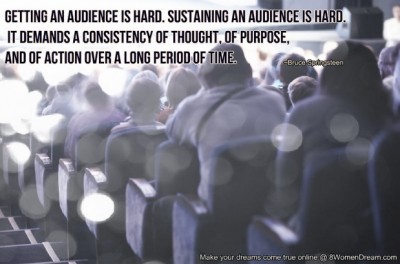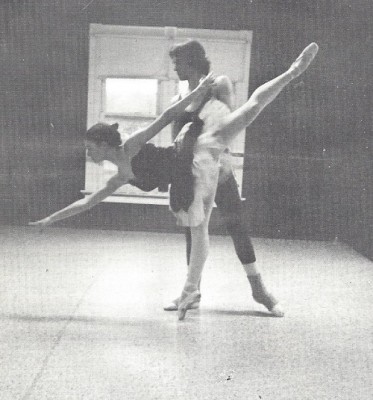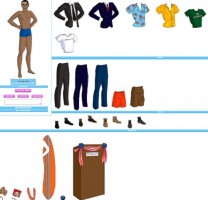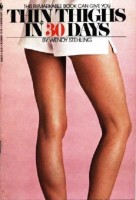Last updated on March 18th, 2023 at 10:17 pm

When I was younger, I was part of a local ballet dance company that performed the Nutcracker Ballet every holiday season. We’d begin rehearsals during summer while our director planned how to fill the auditorium.
Her goal was always to sell out each and every performance. She successfully accomplished this goal, even while poking us with her stick to point out where our technique was flawed.
When it comes to being a success online, you could learn a lot from my ballet coach/director and how she attracted her desired audience to get them to spend a good chunk of their discretionary income on buying tickets to small-town ballet performances.
Think about the last time you spent money on a concert, a performance, or an outing. Why did you spend the money?
What was the draw? What made you go?
Now, my ballet director used conventional advertising portals to showcase her solid dance company and our ties to the community. She’d also play on the local sympathy with her guilt-ridden: “don’t you want to bring your family to see a holiday classic?” = Nutcracker pleas.
And if she wasn’t as brilliant as she was, she might have stopped there.

I don’t think local cultural types would argue that attending a local community ballet with talented dancers offering their version of Nutcracker without having to drive into San Francisco with the parking hassles and expense wouldn’t be enough of a draw to buy tickets if you were into the ballet — but the ballet director knew better.
She understood that there needed to be something unique to secure a sellout of every performance.
Because we were a small ballet company in the middle of the Northern California dairy country, there weren’t many young men scrambling to be the next Mikhail Baryshnikov principal “danzatore” (lead male dancer).
Sometimes in smaller ballet companies, another female ballerina will take on the role of the principal male dancer, much like Peter is played by females in Peter Pan. But our director was never satisfied with that idea. She tried it once with a performance of Cinderella and vowed not to do it again.
To her, there always had to be a male lead — a prince — to sell out a series of performances in the middle of Clo-the-cow county.
So she would bring in a ringer .. or two.
Because our director had once been a prima ballerina with the San Francisco Ballet, she still maintained strong ties to the SF Ballet and one of its directors, Harold Christensen, who in 1942, with his brother, Willam, bought the SF Ballet School from San Francisco Opera.
Every Thursday, Harold Christensen drove from San Francisco to Petaluma to our small upstairs ballet studio in the heart of downtown to teach the “company class” — her 12 top dance students.
And every summer before we’d start rehearsal for the Nutcracker, our director would begin to drill Mr. Christensen on who his top male dancers were and who wasn’t happy that he wasn’t yet lead. From their banter, our director would zero in on one or two of SF Ballet’s male dancers or someone Harold thought would be perfect to be the lead male for our following “country” Nutcracker performances.
Our director would then advertise that a particular male dancer from SF Ballet was making a rare appearance in northern California, and what an affordable opportunity for the entire family! People would come from all over northern California to see a dancer from the San Francisco Ballet.

He was our draw, and she would sell out our performances. We’d also get a fresh crop of beginning ballet dancers inspired by the performances from a small community ballet company.
Getting attention online works in much the same way. You build your platform, and you believe you have a great website … but over time, nothing seems to be happening the way you’d hoped it would as far as visitors are concerned. You fear you may not “sell out” your performance.
You may have a great site, even excellent content, but you need something to draw visitors to your site so they can begin to spread the word about you.
So you need to ask yourself: What is that one thing that would draw people to me?
It’s more than your idea, the design of your site, or the words that you type. Your draw is the thing that will bring people to you–lots of people to you.
It’s like the smell of barbecue drifting towards hungry hikers after a long day on the trail, or the view of the Golden Gate Bridge on your way into San Francisco, or the cute shoes the girl in front of you in line is wearing that you have to ask her about them. The magnet makes people suddenly notice you and pay attention to your actions.
Evan Bailyn, entrepreneur and the author of two books, Outsmarting Google and Outsmarting Social Media, wanted to create a draw for a website he helped his daughter create. Once the site had all its adorable doll content, he began thinking about what could draw people to it.
He pondered over what he could create that would bring traffic and spread the word about this doll site beyond Google advertising, Facebook Pages, Twitter, or any other social media platform.
He was looking for a draw that people would share– both young and old. Evan began to look at Google Trends, news trends, and social media trends to study what the world was talking about at that point in time. It was during the presidential campaign and right at the point of President Obama winning the election.
It was through seeing all of the online buzz about President Obama that he thought up his draw. He created a free President Obama paper doll with funny clothes; you could dress him in surfer attire, khaki shorts, and a Hawaiian shirt.
His draw idea matched the mood of the Internet at the time and was a hot trending topic (pure gold!). When he shared the Presidential paper doll–it went viral–driving a ton of traffic to his daughter’s site. The President Obama paper-doll was the draw that brought mainstream media to his site along with hundreds of thousands of visitors.
I have successfully used this idea many times in the years I’ve been online.
On 8 Women Dream I created an inspirational websites page where I researched 48 of the most inspirational websites I could find that would appeal to dreamers and brought them all together on one page with a description. That one page has brought 8 Women Dream over 200k visitors since its creation.
Now before you go out and create your inspirational website page as a draw to your site, you must first research what your visitors will want to see. So don’t use someone else’s draw — use the idea of a draw, but create one that is unique to YOU and YOUR visitors.
Just like my ballet director knew that northern California residents would be interested in seeing an accomplished male lead from the San Francisco Ballet perform, you have to understand what your ideal visitor wants to see from you.
Maybe it’s you on video creating healthy recipes that are quick, inexpensive, and easy to use for someone at the beginning of their weight loss journey. Or, as a photographer, you list the best colors and styles to wear for a photo shoot — along with makeup and anything else someone could use when being photographed. It really can be something simple if your demographic is interested and it’s presented in a way they see that they need it.
Not sure about creating a draw?
In his book, The Success Principles, Author and motivational speaker Jack Canfield discusses how author, Wendy Stehling, created her big draw. In chapter 19 on feedback, he shares Wendy’s story of needing funding for her agency and how she used feedback to create the small book, Thin Thighs in 30 Days, which she sold for $1.00 per copy.
It ended up selling more than 2.5 million copies in the 1980s and was only supposed to help her agency.
You do the math on that one.
It was one hell of a draw.
Maybe your draw is a page where you list information relating to your niche that people have to hunt all over the Internet to find. You create a page that brings this information together in one place on your website, so they come to you to get it.
An example of this occurred on 8 Women Dream when a past dreamer created a listing page when she became frustrated while searching for information about famous graphic designers. She couldn’t find what she was looking for in search.
She asked around the design community, and people eventually pointed her to famous graphic designer websites and Wikis. She gathered this information together and shared it in a post titled 10 Famous Graphic Designers for Design Dreamers with the hope of helping other graphic design dreamers find famous designers online.
That post took off like a shot. As it turns out, hundreds of thousands of people were looking for the same information she had been searching for on famous graphic designers. They all came to us for that information, and she was able to create a graphic designer following.
That graphic designer list post catapulted the 8 Women Dream website to over 95k visitors a month, and even though its popularity has waned (since 99 Designs borrowed her original idea along with new information about graphic designers being made available online), it is still in the top 10 visited posts on 8 Women Dream.
It’s an old post that still brings us visitors. Now that’s what I call a draw.
Getting attention online is more than offering great content — it’s about figuring out what your followers would want to see from you and creating a draw that matches up with their desire so they can find you. Then sit back and watch them beat a path to your online door.

Catherine Hughes is an accomplished magazine columnist, content creator, and published writer with a background as an award-winning mom blogger. She partners with companies to create captivating web content and social media stories and writes compelling human interest pieces for both small and large print publications. Her writing, which celebrates the resilience and achievements of Northern California’s residents, is featured in several magazines. Beyond her professional life, Catherine is passionate about motherhood, her son, close friendships, rugby, and her love for animals.
Note: Articles by Catherine may contain affiliate links and may be compensated if you make a purchase after clicking on an affiliate link.







